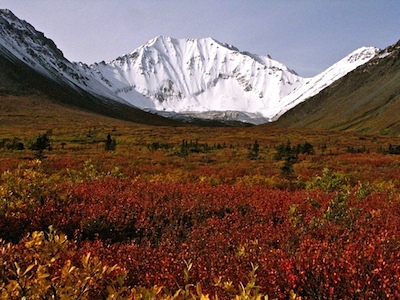 Image Courtesy of Elaine HansonHome of the Southern Tutchone People
Image Courtesy of Elaine HansonHome of the Southern Tutchone People
The region of present-day Haines Junction is Southern Tutchone territory. For many thousands of years, there were seasonal hunting and fishing camps in the area. It was a tenuous life, and the location of camps fluctuated over this stretch of time with the ever-changing landscape.
"Dakwäkäda", a Southern Tutchone word meaning "high cache", was the original name for the site of Haines Junction. It was common for Southern Tutchone people to use raised log caches to store food year-round, or temporarily, while they hunted and fished in an area.
This region was also an important travel and trade route for First Nations. Its proximity to the Chilkat Pass, one of only three passes that allowed travel between the coast and the interior, made for extensive use by coastal Tlingit and Southern Tutchone people; there were a number of trading settlements, and well-travelled trails led in all directions.
Ancient Travel Routes Become Roads - Haines Junction Established
The establishment of Haines Junction dates back to 1942 and the construction of the Alaska Highway during WWII. The following year, a branch road was built from Haines, Alaska, over the Chilkat Pass to join the Alaska Highway. Portions of ancient travel routes became pioneer roads built for vehicle traffic. Situated at the junction of these two roads, Haines Junction was a construction camp and an important supply and service centre for the U.S. Army Corps of Engineers who were building the highway.
Haines Junction Becomes Administration Centre for a National Park
In the same year as the construction of the highway, the Kluane Game Sanctuary was established. In 1972, most of it was designated the Kluane National Park Reserve. Haines Junction is the headquarters for Park administration and the community is also the main staging area for operations. See Kluane National Park and Reserve for more information.
The Community Today
Haines Junction has evolved from a construction camp and service centre into a global village of over 800 culturally diverse people. While there are a few 'founding' residents remaining in the community today, the residential base of Haines Junction is a kaleidoscope of people from throughout Canada and the world. Many residents are Champagne and Aishihik First Nations - Southern Tutchone people whose main administration centre is located in the community. First Nations continue to use the land in their traditional ways: hunting, trapping and fishing. They have also developed community investments in business, tourism and cultural ventures.
Amoung the many reasons people have chosen to call Haines Junction their home, the natural environment, stable economy and the array of community services rank high on the list.
Today our community boasts an excellent array of federal, territorial and municipal programs and services. These, along with the valued contributions of the local clubs and various volunteer groups, result in Haines Junction being a vibrant community that boasts a wide array of recreation, leisure and cultural offerings which enhance the vitality, spirit and character of the community.
Year-Round Destination
Haines Junction continues to service Alaska Highway travelers, but today it is also a year-round destination in its own right. Yukoners, Alaskans and visitors from around the world come to partake in wilderness, adventure and eco-tourism opportunities.